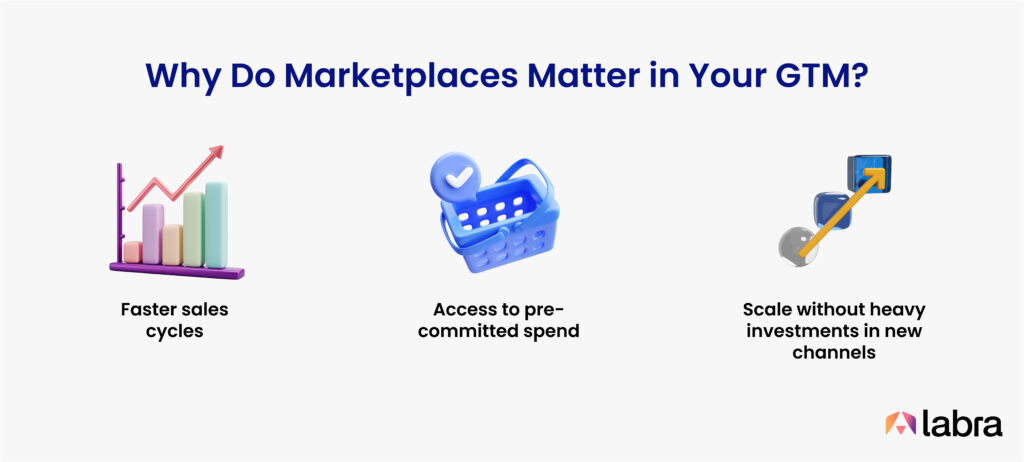Cloud Marketplaces are digital storefronts that help ISVs get discovered and deployed faster.
They’re now a key growth driver, boosting GTM momentum and revenue.
In this blog, we unpack marketplace-led growth and how to make Marketplaces a core part of your strategy.
What is Marketplace-Led Growth?
Marketplace‑Led Growth (MLG) refers to building your distribution, sales, and revenue strategy around cloud marketplaces.
Instead of relying solely on direct sales or partner‑reseller models, you list your product on cloud marketplaces where customers can discover, purchase, and deploy your solution seamlessly.
These aren’t your average app stores. Cloud marketplaces are enterprise-grade procurement hubs directly integrated with AWS, Azure, and Google Cloud.
Here’s a brief breakdown of the evolution of Marketplace-led Growth (MLG):
| Timeline | Description | Result |
| Traditional Software Sales | In the early days, software was sold like a physical product. Companies purchased perpetual licenses, installed them on their own servers, and maintained them internally. Sales cycles were long, procurement was complex, and upgrades often meant buying entirely new versions. | High upfront costs and little flexibility. |
| Early Cloud Adoption (SaaS) | Then came the cloud revolution. Software-as-a-Service (SaaS) disrupted the market by offering subscription-based models, hosted in the cloud. Businesses could now scale quickly, pay only for what they used, and avoid the headache of on-premise infrastructure. | Faster deployment, lower costs, and broader accessibility. |
| Public Cloud Platforms | As cloud computing evolved, public cloud platforms such as AWS, Azure, and GCP became the foundation of modern software delivery. These platforms offered robust infrastructure and opened doors for developers to innovate and reach global audiences. | A reliable backbone for building and scaling software. |
| Vendor‑Specific Marketplaces | Cloud providers saw an opportunity and launched their own marketplaces. Here, vendors could list their solutions, and customers could procure them instantly, all within their chosen cloud ecosystem. | Easier discovery and streamlined purchasing. |
| Co‑Sell Programs | Next came co-sell programs, where cloud providers and Independent Software Vendors (ISVs) teamed up. By collaborating on deals, they combined reach, credibility, and resources to drive adoption faster than ever. | A win‑win partnership model. |
| Multi‑Cloud Marketplaces | As businesses adopted multiple clouds, marketplaces evolved to be platform‑agnostic. Now, buyers could discover and deploy software across clouds without being tied to a single vendor. | More flexibility, reduced vendor lock‑in, and broader market reach. |
| Automated Procurement & Governance | Modern marketplaces started integrating automation into procurement and governance. With built‑in compliance, budgeting tools, and cost optimization, businesses could buy software quickly without sacrificing oversight. | Faster decision-making with fewer risks. |
| Multi‑AI‑Driven Insights & Analytics | Today, marketplaces are entering an AI-driven era. Intelligent analytics provide insights on buyer behavior, pricing strategies, and sales forecasts. Sellers can fine‑tune their offerings, while buyers get tailored recommendations. | Smarter decisions, optimized growth, and a truly data‑driven marketplace experience. |
Why Do Marketplaces Matter in Your GTM?
Faster Sales Cycles
Legal and compliance reviews that once delayed procurement for weeks are shrinking thanks to standardized licenses like Microsoft’s Commercial Marketplace Terms. Buyers gain speed and assurance; vendors get a repeatable, scalable sales motion. No surprise it’s catching on in tightly regulated sectors—finance, healthcare, and government.
A commissioned study by Forrester reports that organizations buying through AWS Marketplace experience a 60% faster procurement process.
Access to Pre‑Committed Cloud Spend
Many large enterprises have millions committed to cloud providers. Buying through marketplaces lets them burn down their committed spend instead of requesting a new budget.
Cloud commitments have now reached $439B, with $20B added just in Q1 2025.
Scale Without Heavy Investment in New Channels
Listing on a marketplace instantly gives your product visibility to thousands of cloud customers — without setting up regional subsidiaries or negotiating new reseller agreements.
How to Leverage Cloud Marketplaces in Your GTM
Here’s how to make marketplaces a growth engine:
List Your Product Strategically
Each marketplace has its own listing requirements (AMI, SaaS contracts, containers, etc.). Start with the marketplace most aligned with your current customer base:
- If most of your customers run on AWS → AWS Marketplace.
- If you’re in Microsoft ecosystems (M365, Azure AD) → Azure Marketplace.
Pro Tip: Optimize your listing with clear product descriptions, usage‑based pricing, and customer testimonials.
Enable Private Offers
Beyond public listings, marketplaces offer Private Offers — custom pricing, terms, or enterprise agreements negotiated directly but transacted through the marketplace.
Forrester also reported that partners who developed marketplace practices experienced a 133% increase in new business directly linked to private offers.
Pro tip: Sweeten the deal by including onboarding or premium support as part of a private offer.
Integrate Marketplace into Your Sales Motion
Equip your sales teams to lead with a marketplace option:
- Train reps on how to explain committed spend benefits.
- Include marketplace SKUs in proposals.
Pro tip: Partner with the cloud provider’s marketplace team—they often help co‑sell and bring leads.
Track and Optimize
Marketplaces provide dashboards and analytics:
- Track top accounts buying via marketplace.
- Adjust pricing models (SaaS subscriptions, PAYG) based on buyer behavior.
Pro tip: If you have listed on multiple cloud marketplaces, a platform like Labra can consolidate all your revenue details in one interface.
Key Takeaways
Marketplace‑Led Growth is about meeting your customers where they want to buy. By leaning into AWS, Azure, or GCP marketplaces, you not only simplify procurement but also future‑proof your GTM.
- Cloud marketplaces are a proven GTM engine.
- They accelerate deals, tap into committed spend, and unlock global scale.
- By listing strategically, enabling private offers, and integrating into your sales motion, you can drive meaningful revenue through a marketplace‑led approach.
Labra helps you list faster and scale quicker on cloud marketplaces. You don’t have to dedicate separate teams or time to lead this effort — Labra takes care of it for you.
Want to know more? Book a demo here.







